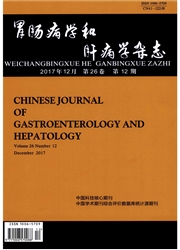

 中文摘要:
中文摘要:
目的了解肝硬化合并门静脉血栓形成(PVT)的危险因素及预后。方法收集99例肝硬化合并门静脉血栓患者临床资料作为PVT组,将同期100例肝硬化无PVT患者作为对照组,进行对比研究,分析PVT形成的危险因素、临床特征及预后。结果我院肝硬化患者PVT发病率为12.9%。PVT组腹痛、发热、腹水、上消化道出血发生率、病死率明显高于对照组(P〈0.05)。PVT组糖尿病史、脾切除史、曲张静脉硬化剂治疗史、血红蛋白下降明显高于对照组(P〈0.05)。PVT死亡组较存活组住院天数延长、ChildC级比例高(P〈0.05)。结论PVT加重肝硬化临床症状,恶化预后。糖尿病史、脾切除史、曲张静脉硬化剂治疗史、血红蛋白下降是肝硬化形成PVT的预测因素。ChildC级、住院时间延长提示肝硬化并PVT患者预后不良。
 英文摘要:
英文摘要:
Objective To explore the risk factors and prognosis of portal vein thrombosis (PVT) in patients with liver cirrhosis. Methods The data of 99 patients diagnosed as liver cirrhosis with PVT were analyzed as PVT group. One hundred patients with liver cirrhosis however no PVT were in control group. Then the risk factors, clinical characters and prognosis were contrastively analyzed. Results The occurrence of PVT in patients with liver cirrhosis was 12.9%. The incident rate of abdominal pain,fever, ascites ,upper gastrointestinal bleeding and mortality in the PVT group were higher than those in the control group (P 〈 0.05 ). It was of higher frequency for PVT group to show diabetes mellitus, spleneetomy and variceal endoscopic sclerotherapy than the control group, but the PVT group showed lower levels of hemoglobin ( P 〈 0.05 ). Among PVT patients, death group showed longer hospital stays and more Child-Pugh classification C than survival group ( P 〈 0. 05 ). Conclusion PVT aggravates clinical symptom in liver cirrohsis patients and has bad influence on prognosis. Diabetes mellitus, splenectomy, variceal en- doscopic sclerotherapy and low levels of hemoglobin may be risk factors for PVT. Patients with Child-Pugh C and long hospital stays may forcast poor prognosis.
 同期刊论文项目
同期刊论文项目
 同项目期刊论文
同项目期刊论文
 期刊信息
期刊信息
